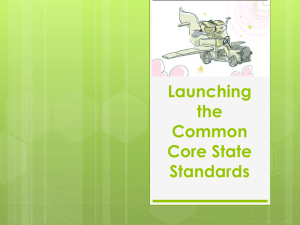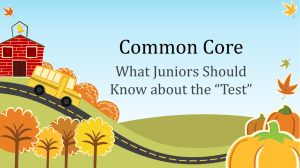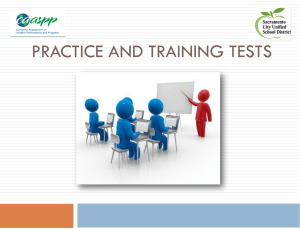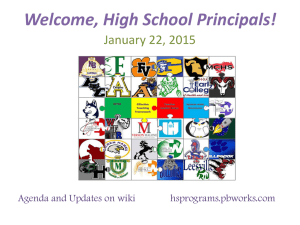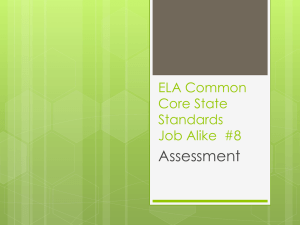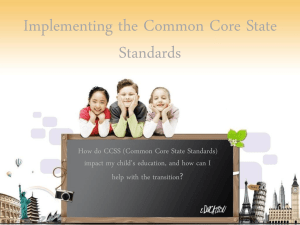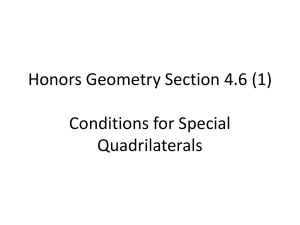File - Instructional planning for students with disabilities
advertisement
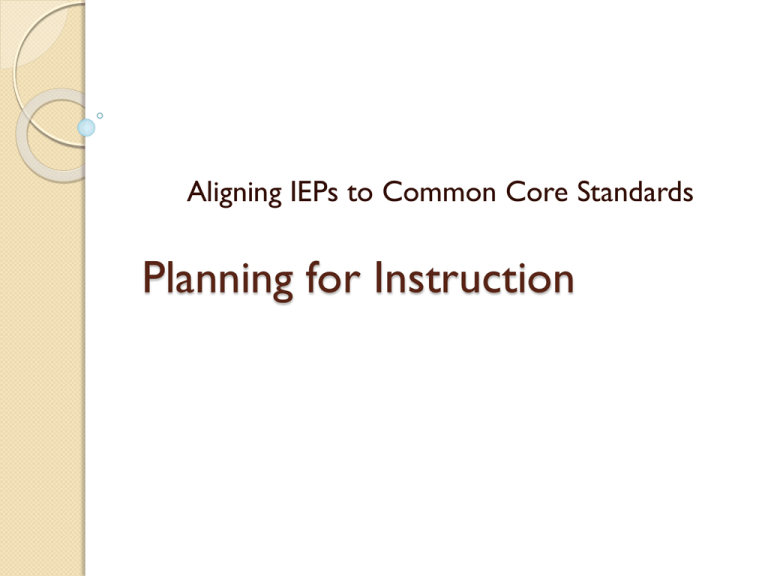
Aligning IEPs to Common Core Standards Planning for Instruction Activity Read and discuss: “An Interview with Dr. Margaret McLaughlin” From: Advocacy Brief from the National Center for Learning Disabilities: Understanding the Standards-based Individualized Education Program (IEP), pages 9-11 © National Center for Learning Disabilities 2008. HO 1 INSERT from MAX Teaching (Forget) Agree ? Questions ! Challenging Key Ideas IEP teams need to address BOTH ◦ critical foundation skills and, ◦ skills and knowledge in the grade-level content Intervention Specialists need to have to have a deep understanding of grade level subject matter content All people who are involved in the IEP development must know how to assess the student in relationship to the grade-level content demands Three Instructional Shifts: ELA 5 Common Core Shifts for English Language Arts/Literacy Building knowledge through content-rich nonfiction Reading, writing and speaking grounded in evidence from text, both literary and informational Regular practice with complex text and its academic language Key Instructional Impacts Close reading of shorter text Focus on informational text Deep integration of reading and writing ◦ Argument vs persuasion Conscientious approach to vocabulary development Combining standards Text-dependent questions Use of progressively more complex text ELA and the Common Core Deconstructing standards Identifying skills and content Formative assessment Extended Standards Standards –Based IEP goals Aligning instruction to grade level content Providing intervention for targeted skills Lets unpack an ELA standard Let’s unpack an ELA standard Reading Standards for Informational Text Key Ideas and Details: Grade 3 #1. Select the standard: RI.3.2 Determine the main idea of a text; recount the key details and explain how they support the main idea. page 41 of Navigating Assessment and Collaboration with the CCSS Let’s unpack an ELA standard Reading Standards for Informational Text Key Ideas and Details: Grade 3 Step #2-3: Underline the concepts, circle the skills Determine the main idea of a text; recount the key details and explain how they support the main idea. Let’s unpack an ELA standard Reading Standards for Informational Text Key Ideas and Details: Grade 3 Step #2-3: Underline the concepts, circle the skills Determine the main idea of a text; recount the key details and explain how they support the main idea. Let’s unpack an ELA standard Reading Standards for Informational Text Key Ideas and Details: Grade 3 Step #2-3: Determine the level of rigor for each skill? Determine the main idea of a text; recount the key details and explain how they support the main idea. Let’s unpack an ELA standard Reading Standards for Informational Text Key Ideas and Details: Grade 3 Step #4: Create a Graphic Organizer (Determine the level of rigor for each skill) Determine—Knowledge Recount—Comprehension Explain--Comprehension page 41 of Navigating Assessment and Collaboration with the CCSS Now You Practice Take a grade level ELA standard and unpack it. ◦ underline the concepts and circle the skills. ◦ Determine the level of rigor for each skill according to Bloom’s Let’s unpack an ELA standard Reading Standards for Informational Text Key Ideas and Details: Grade 3 Step 5: Generate Big Ideas Determine the main idea of a text; recount the key details and explain how they support the main idea. ◦ The main idea is what a text is mostly about ◦ Details must relate directly to the main idea ◦ A recounting of text is a sequential retelling of the important information Let’s unpack an ELA standard Reading Standards for Informational Text Key Ideas and Details: Grade 3 Step 6: Create Essential Questions Determine the main idea of a text; recount the key details and explain how they support the main idea. ◦ How do you determine what information in a text is important/relevant ◦ How do you determine what a text is mostly about ◦ What are the essential components of a recounting Relationship of Concepts and Skills, Essential Questions, and Big Ideas Big Ideas Essential Questions Concepts and Skills Navigating Assessment and Collaboration with the CCSS page 42 Let’s unpack an ELA standard Reading Standards for Informational Text Key Ideas and Details: Grade 3 Step 7: Check your work ◦ Seek feedback from others to ensure what you have “unpacked” makes sense and is accurate The importance of connections Why We Need the Common Core Steps for Developing Standards Based Goals (Handout) Assess to determine present levels Choose a grade level standard Unpack (Deconstruct) the Standard Analyze the sub-skills (and concepts) Writing Standards Based Goals Using standards as the starting point: Write goals that address the prerequisite skills and the conditions needed to access the grade level concepts Let’s give it a go………….. http://instructionalplanningforswdsst3.weebly.com Mathematical Practices 1. Make sense of problems and persevere in solving them. 2. Reason abstractly and quantitatively. 3. Construct viable arguments and critique the reasoning of others. 4. Model with mathematics. 5. Use appropriate tools strategically. 6. Attend to precision. 7. Look for and make use of structure. 8. Look for and express regularity in repeated reasoning. Math Standards define what students should understand and be able to do. Clusters are groups of related standards. Note that standards from different clusters may be closely related, because mathematics is a connected subject Domains are larger group of related standards. Standards from different domains may sometimes be closely related Lets unpack a Math standard Let’s unpack a Math standard Grade 4 Draw and identify lines and angles 4.G.2: Classify two-dimensional figures based on the presence or absence of parallel or perpendicular lines, or the presence or absence of angles of a specified size. Recognize right triangles as a category, and identify right triangles. 4.G.2: Classify two-dimensional figures based on the presence or absence of parallel or perpendicular lines, or the presence or absence of angles of a specified size. Recognize right triangles as a category, and identify right triangles. Questions to consider 1. What are possible units based on the concepts and skills? 2. How can concepts be grouped to better determine priority skills? 3.The skills are global – what precise skills do I expect 5th grade students to master based on the skills listed above? 4. Are targeted skills aligned to the units? Now You Practice 4.G.1 Draw points, lines, line segments, rays and angles (right, acute, obtuse), and perpendicular and parallel lines. Identify these in two dimensional figures. Now You Practice 3.G.1 Understand that shapes indifferent categories (e.g., rhombuses, rectangles, and others) may share attributes (e.g., having four sides), and that the shared attributes can define a larger category (e.g., quadrilaterals). Recognize rhombuses, rectangles, and squares as examples of quadrilaterals, and draw examples of quadrilaterals that do not belong to any of these subcategories. Sample Goal Goalbook 4.G.1 Draw and identify lines and angles, and classify By (date), when given a selection of two-dimensional objects (points, line segments, rays, right/acute/obtuse angles, and perpendicular and parallel lines), (name) will match the twodimensional object with its correct name for (8 out of 10) objects. By (date), when given a selection of two-dimensional objects (points, line segments, rays, right/acute/obtuse angles, and perpendicular and parallel lines), name will work with a group of peers to match the two-dimensional object with its correct name and identify the object in twodimensional figures for (8 out of 10) objects. Sample Goal Goalbook 3.G.1 Reason with shapes and their attributes By (date), when given (10) shapes including (rhombuses, rectangles, and squares) and a glossary of labeled examples of different shapes, (name) will name the shape and classify the shape as a quadrilateral or not, scoring (8/10) names and classifications correctly. By (date), when given (10) paper shapes, shape name cards, and two bins (one bin that says "Quadrilateral" and one bin that says "NOT a Quadrilateral"), (name) will match the shape to the name and place it in the correct bin classifying the shape as a quadrilateral or not, scoring (8/10) names and classifications correctly. Sample Goal Goalbook 3.G.1 Reason with shapes and their attributes By (date), when given (5) paper shapes, shape name cards, and two bins (one bin that says "Quadrilateral" and one bin that says "NOT a Quadrilateral"), (name) will work one on one with an adult who will provide hand over hand support to match the shape to the correct name card, and then with verbal and visual prompts (e.g. adult touches and counts each side), (name) will place the shape in the correct bin classifying the shape as a quadrilateral or not, scoring (4/5) names and classifications correctly. Making Connections Learning Model Progressions Curriculum Extended Standards Standards Based Goals Activity Now… ◦ ◦ ◦ ◦ ◦ Deconstruct/Unpack a standard Identify skills and concepts Refer to goalbook for goal ideas Write sample goals for your standard Use CRITICAL FRIEND template to analyze your sample goal Resources Instructional Planning for SWD http://instructionalplanningforswdsst3.weebly.com Battelle for Kids http://portal.battelleforkids.org/FIPOhio/fip-home?sflang=en ODE Model Curricula http://education.ohio.gov/Topics/AcademicContentStandards/Mathematics Learning Progressions http://math.arizona.edu/~ime/progressions/ ODE Extended Standards http://education.ohio.gov/Topics/Special-Education/Students-With-Disabilities-1 Goalbook https://goalbookapp.com/teachers NOTE: Goalbook is a commercial site. The goal samples used are for training purposes only. They are NOT intended as “exemplars”. Contact Information Angie Chapple-Wang angie.chapple-wang@esc-cc.org Paula Woods paula.woods@esc-cc.org FIP – Formative Instructional Practices Battelle for Kids - FIP instructional Modules http://portal.battelleforkids. org/FIPOhio/fiphome?sflang=en Common Core Grades K-5 Operations and Algebraic Thinking Addition, subtraction, multiplication, division Patterns and expressions Numerical expressions Whole numbers *Numbers and Operations in Base Ten Place Value Counting Sequence Properties and Operations Multi-Digit Arithmetic Numbers and Operations – Fractions (Grades 3-5) Fractions as numbers Fraction equivalents Decimal notations Add and Subtract Fractions Measurement and Data Measurable attributes Classification and Categorization Time Length units Represent and interpret data .Geometric measurements Geometry Shapes and their attributes Classification Graphing


